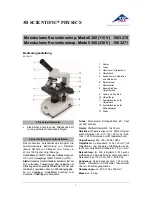
1
2
Turning the Lamp ON
Placing specimen on the stage
13
DETAILED OBSERVATION PROCEDURE
10
Fig. 11
Fig. 10
1
Cover glass
Slide glass
Placing Specimen
Fig. 12
1. Rotate the On/OFF control knob
” ”
as shown in figure 10.
2. Rotating the light intensity adjustment knob (fig. 10) in the direction of
the arrow increases brightness and rotating it in the opposite direction
decreases brightness.
3. The intensity adjustment knob illuminates “Green” when battery is fully
charged. It starts to turn “Red” as the battery needs to be recharged.
Recharge the battery when Red light is noticed.
to
I
(ON)
Place the specimen gently on the stage and secure it beneath the
stage clips (figure 11).
1. Rotate the coarse adjustment knob (1) anticlockwise to fully lower the
stage.
2. Press the stage clips (2) one by one with finger to lift them from front.
Place the specimen by sliding the specimen glass plate on the stage
from the front toward the rear.
3. After positioning your specimen slides, release the stage clips gently
on the slide to hold it tight.
When the specimen is placed, do not move it with the stage clips
resting on it. Lift the stage clips and move the specimen to avoid
damage to stage surface and the specimen slide.
Cover glass
This is the glass plate placed on the specimen. For optimum optical
performance, the cover glass thickness, which is the distance from its
surface to the specimen surface, should be 0.17 mm.
Slide glass
This glass plate should ideally have a length of 76mm, width of 26mm
±1mm and thickness between 0.9 and 1.4mm.
1
2
Содержание Sigma
Страница 2: ......




































